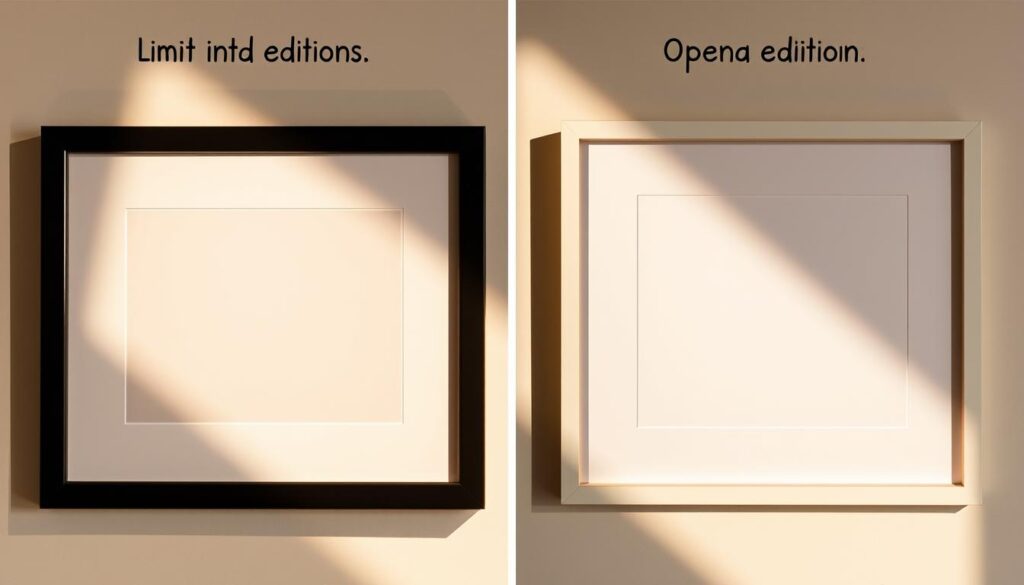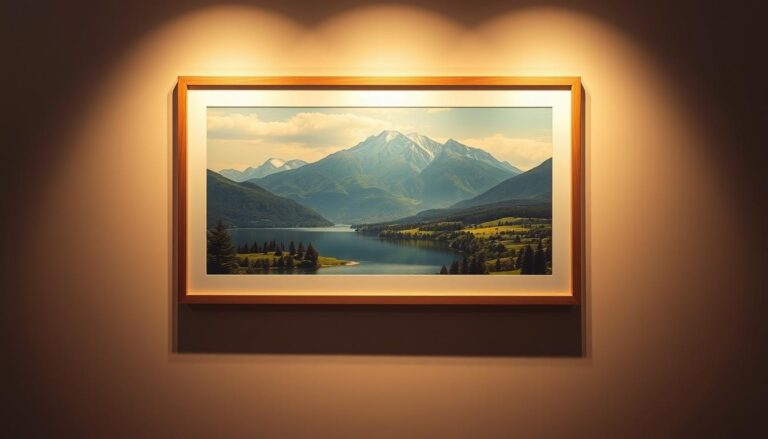If you’ve ever browsed art galleries or shopped for wall decor, you’ve likely heard the term “giclee.” This method creates museum-quality reproductions of original paintings, photos, or digital designs. Unlike standard posters, these pieces use advanced inkjet technology to capture every brushstroke and hue.
The process starts with high-resolution scans of the original artwork. Specialized printers then apply archival pigment-based inks layer by layer. These inks resist fading for decades, especially when paired with acid-free cotton or canvas papers. The result? A vibrant, textured piece that mirrors the artist’s vision.
Artists often choose this technique to share their work affordably without sacrificing quality. Collectors appreciate the balance between accessibility and exclusivity, especially with limited-edition releases. The word itself comes from the French “gicler,” meaning “to spray,” referencing how the printer applies ink droplets.
Whether you’re decorating a home or starting a collection, understanding this term helps you make informed choices. It bridges the gap between original masterpieces and budget-friendly alternatives while preserving color accuracy and detail.
Understanding Giclee Print: Definition and Origins
Art lovers seeking gallery-quality reproductions often discover a game-changing method developed decades ago. This technique combines cutting-edge technology with artistic integrity to create pieces that rival originals.
Defining the Giclee Technique
Unlike mass-produced posters, this approach uses specialized inkjet printers with microscopic precision. Each droplet of pigment-based ink gets strategically applied to archival materials like cotton rag paper. The process captures subtle textures and color gradients that standard methods miss.
The French Roots and Evolution
The term originates from the French word “gicler,” meaning “to spray.” It gained traction in 1991 when printmaker Jack Duganne sought a name for this emerging art form. Early adopters praised its ability to preserve vibrant hues for over 100 years with proper care.
Modern studios use high-resolution scanners and color-calibrated monitors to ensure perfect matches to original artwork. This attention to detail makes these reproductions preferred by galleries and collectors worldwide. Limited edition releases maintain exclusivity while remaining more accessible than one-of-a-kind pieces.
How Giclee Prints Are Made
Creating museum-quality reproductions starts with precision technology. Artists and studios use specialized scanners to capture original artwork at 300 DPI or higher. This ensures every texture and subtle color shift remains intact.
High Resolution Inkjet Technology
Advanced printers spray microscopic ink droplets to build continuous-tone images. Devices like Iris models use up to twelve pigment-based colors for unmatched depth. The result? Smooth gradients that mirror hand-painted details.
Choosing Archival Inks and Specialty Paper
Long-lasting vibrancy comes from lightfast inks tested to resist fading for a century. These pair perfectly with acid-free cotton or canvas sheets. The combination protects against yellowing while enhancing texture.
Color calibration is key throughout the process. Experts adjust digital files on calibrated monitors before printing test proofs. Only after perfecting hues and contrasts does the final production begin.
Benefits of Giclee Prints for Artists and Collectors
For creators and art enthusiasts alike, high-quality reproductions have transformed how we experience visual works. These pieces bridge the gap between original masterpieces and accessible decor, offering lasting value through cutting-edge techniques.
Color and Detail
Modern inkjet printers deliver astonishing precision. They layer microscopic droplets of pigment-based inks to replicate textures like brushstrokes or watercolor blooms. This process captures gradients and shadows often lost in traditional methods.
Archival materials play a key role. Acid-free cotton or canvas sheets paired with fade-resistant inks ensure colors stay vibrant for generations. A 2022 study found these reproductions retain 95% of their original hue after 75 years under proper lighting.
Affordability Without Compromising Quality
Emerging artists gain new opportunities. Instead of selling one original painting for thousands, they can offer limited edition reproductions at a fraction of the cost. This expands their audience while maintaining artistic integrity.
Collectors benefit too. A $300 fine art print might mirror a $15,000 original’s essence. Galleries report a 40% increase in first-time buyers opting for these high-quality alternatives, proving accessibility fuels art appreciation.
Comparing Giclee Prints with Traditional Fine Art Prints
When selecting wall art, understanding reproduction methods helps you appreciate what makes each piece unique. Traditional techniques like lithography and screenprinting dominated galleries for decades, but modern approaches now offer new possibilities for detail and longevity.
Key Differences in Reproduction Techniques
Traditional methods often involve transferring images through plates or screens, which can soften details. A lithograph might use four-color separation, blending dots to create hues. This limits color accuracy compared to modern pigment-based systems that mix 12+ shades.
Advanced inkjet technology captures textures like canvas weave or watercolor paper grain. Museums increasingly use this method for exhibition reproductions – the Van Gogh Museum’s traveling shows feature pieces indistinguishable from originals under glass.
Archival standards differ significantly. While older prints might use acidic paper fading in 20 years, modern materials resist deterioration. The Museum of Modern Art’s conservation team notes these reproductions often outlast their 19th-century counterparts when displayed properly.
Artists benefit from flexible edition options. Limited edition releases maintain collectibility, while open editions make beloved works accessible. This versatility helps creators balance artistic value with audience reach.
Choosing the Right Printer for Your giclee print
Selecting the perfect studio for your reproductions requires more than a quick online search. Quality outcomes depend on three pillars: advanced technology, skilled technicians, and trustworthy partnerships. Let’s explore how to identify studios that elevate your work.
Evaluating Equipment and Technical Expertise
Start by asking about the printers’ capabilities. Top-tier studios use 12-color inkjet systems with ultra-high resolution. These machines handle subtle gradients and deep blacks better than basic models. Request proof prints to see how they render shadows and textures.
Technical knowledge matters just as much as hardware. Skilled operators adjust color profiles for different papers and lighting conditions. Artist Sarah K. Thompson notes: “My studio caught a 5% cyan imbalance I’d missed – that attention saved my limited edition release.”
Building Long-Term Relationships with Reputable Studios
Consistency is key for series or open edition projects. Visit potential partners to review paper samples and archival certifications. Do their materials meet ISO standards for fade resistance? Trustworthy providers share test results openly.
Industry platforms like Fine Art Trade Guild list vetted printers. Many artists recommend starting with small batches to assess reliability. Over time, a collaborative studio becomes an extension of your creative process, anticipating needs like custom sizing or specialty substrates.
Edition Options: Limited Edition vs Open Edition Prints
Artists and collectors face a crucial decision when reproducing work: limited or open editions? Each choice impacts accessibility, value, and artistic strategy. Let’s explore how these options shape the art market and creative careers.

Advantages of Limited Edition Giclee Prints
Limited editions create scarcity by capping production numbers—often 50 to 500 copies. This exclusivity boosts perceived value, attracting collectors who view them as investments. A numbered certificate of authenticity adds prestige, making each piece feel unique.
Galleries frequently price these higher due to their rarity. For example, an artist might release 100 signed copies priced at $800 each instead of unlimited $200 versions. This approach maintains demand while honoring the original artwork’s integrity.
The Flexibility of Open Edition Reproductions
Open editions remove quantity restrictions, letting artists meet ongoing demand. This works well for popular designs or emerging creators building their audience. Affordable pricing—often 60% lower than limited runs—makes art accessible to first-time buyers.
Artists can experiment with sizes and paper types without worrying about edition counts. A nature photographer might offer open editions in five formats, from budget-friendly 12×18″ prints to large statement pieces. This flexibility supports creative growth and steady income.
Balancing both approaches helps artists cater to different markets. Limited editions satisfy collectors seeking exclusivity, while open editions foster broader connections. Smart creators often mix strategies—using limited releases for signature works and open batches for experimental pieces.
Techniques to Ensure Optimal Image and Color Accuracy
Achieving true-to-life reproductions demands more than just a good eye—it requires precision tools and techniques. Professionals combine high-resolution scanning with carefully chosen materials to mirror original artwork’s essence.
The Importance of High Resolution Scanning
Capturing intricate details starts with scanners that operate at 600 DPI or higher. These devices document brushstrokes, paper textures, and subtle color transitions invisible to standard equipment. Leading studios use multiple scans per artwork, stitching them digitally for flawless accuracy.
Color calibration happens at every stage. Technicians compare digital files to originals under controlled lighting, adjusting hues until they match perfectly. This meticulous process ensures reproductions meet gallery standards, whether creating limited editions or open runs.
Selecting Premium Inks and Fine Art Paper
Archival pigment-based inks resist fading better than dye-based alternatives. When paired with acid-free cotton or bamboo paper, they preserve vibrancy for over a century. The right substrate enhances texture—watercolor paper mimics painterly effects, while canvas adds depth to photographic works.
Artists should request material samples before large projects. Testing different combinations reveals how inks interact with surfaces. For digital files, export at 300 PPI resolution and use Adobe RGB color profiles to maintain consistency during giclee printing.
Conclusion
Fine art reproduction has evolved into a harmonious blend of innovation and craftsmanship. Through precise techniques and archival materials, creators preserve intricate details while making works accessible to broader audiences. This balance transforms how we experience visual culture.
Choosing premium papers and calibrated printers ensures lasting vibrancy. Artists gain flexibility through edition strategies—limited releases maintain exclusivity, while open formats invite discovery. Collectors enjoy museum-worthy pieces at approachable price points without sacrificing depth or texture.
Whether expanding a personal collection or sharing creative visions, these methods empower meaningful connections with art. Ready to explore? Partner with studios prioritizing color accuracy and material excellence. Together, we keep artistic legacies alive while embracing modern possibilities.
